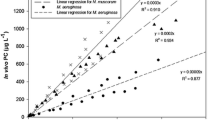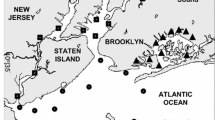Abstract
Pulsed N inputs were simulated by exposing Alexandrium tamarense to sudden increase in concentration of three different N sources to evaluate an approach of using absorption coefficient (a ph) ratio at three wavelengths to detect toxic dinoflagellates such as A. tamarense. The present study examined the absorption properties of A. tamarense for a range of concentrations under three different nitrogen sources and concluded that using absorption such as chlorophyll-specific absorption coefficient (a *ph ) at a single wavelength is not appropriate for detecting bloom forming species due to variability of a *ph caused by varying physiological states. With appropriate wavelengths established, the a ph ratio approach with three wavelengths has the capability of detecting A. tamarense. Variable environmental conditions such as nutrient species, light quantity and light quality did not affect the a ph ratios significantly, particularly the ratio at 510 and 675 relative to 555 nm. This ratio allows differentiation of A. tamarense from other phytoplankton species including other bloom-forming dinoflagellates. In addition, this ratio could also detect the presence of A. tamarense in mixed cultures from diluted samples of as low as 5% in cell abundance (c. 30% in Chl a concentration). The present study suggests that this ratio could be an adequate biomarker for dinoflagellates such as A. tamarense. This absorption ratio technique could provide means of interpreting field populations and enhancing the capability for detecting harmful species such as A. tamarense.
Similar content being viewed by others
References
Butler W. L. and Hopkins D. W. (1970). An analysis of fourth derivative spectra. Photochemistry and Photobiology 12: 451–456
Cleveland J. S. and Weidemann A. D. (1993). Quantifying absorption by aquatic particles: a multiple scattering correction for glass-fiber filters. Limnology and Oceanography 38: 1321–1327
Glibert P. M., Magnien R., Lomas M. W., Alexander J., Haramoto E., Trace M. and Kana T. M. (2001). Harmful algal blooms in the Chesapeake and coastal bays of Maryland, USA: comparison of 1997, 1998, and 1999 events. Estuaries 24: 875–883
Guillard R. R. and Ryther J. H. (1962). Studies of marine planktonic diatoms. 1. Cyclotella nana Hustedt and Detonula confervacea (Cleave.) Gran. Canadian Journal of Microbiology 8: 229–239
Head E. J. H. and Horne E. P. W. (1993). Pigment transformation and vertical flux in an area of convergence in the North Atlantic. Deep-Sea Research II 40: 329–346
Hoepffner N. and Sathyendranath S. (1991). Effect of pigment composition on absorption properties of phytoplankton. Marine Ecology Progress Series 73: 11–23
Johnsen G., Samset O., Granskog L. and Sakshaug E. (1994). In vivo absorption characteristics in 10 classes of bloom-forming phytoplankton: taxonomic characteristics and responses to photoadaptation by means of discriminant and HPLC analysis. Marine Ecology Progress Series 105: 149–157
Kishino M., Takahashi M., Okami N. and Ichimura S. (1985). Estimation of the spectral absorption coefficients of phytoplankton in the sea. Bulletin of Marine Science 37: 634–642
Leong S. C. Y., Murata A., Nagashima Y. and Taguchi S. (2004). Variability in toxicity of the dinoflagellate Alexandrium tamarense in response to different nitrogen sources and concentrations. Toxicon 43: 407–415
Leong S. C. Y. and Taguchi S. (2004). Response of the dinoflagellate Alexandrium tamarense to a range of nitrogen sources and concentrations: growth rate, chemical carbon and nitrogen and pigments. Hydrobiologia 515: 215–224
Leong S. C. Y. and Taguchi S. (2005). Optical characteristics of the harmful dinoflagellate Alexandrium tamarense in response to different nitrogen sources. Harmful Algae 4: 211–219
Millie D. F., Kirkpatrick G. J. and Vinyard B. T. (1995). Relating photosynthetic pigments and in vivo optical density spectra to irradiance for the Florida red-tide dinoflagellate Gymnodinium breve. Marine Ecology Progress Series 120: 65–75
Millie D. F., Schofield O. M., Kirkpatrick G. J., Johnsen G., Tester P.A. and Vinyard B. T. (1997). Detection of harmful algal blooms using photopigments and absorption signatures: a case study of the Florida red tide dinoflagellate, Gymnodinium breve. Limnology and Oceanography 42: 1240–1251
Mitchell B. G. and Kiefer D. A. (1988). Chlorophyll a specific absorption and fluorescence excitation spectra for light-limited phytoplankton. Deep-Sea Research 35: 639–663
Morel A. and Bricaud A. (1981). Theoretical results concerning light absorption in a discrete medium and application to specific absorption of phytoplankton. Deep-Sea Research 28: 1375–1393
Seitzinger S. P. and Sanders R. W. (1997). Contribution of dissolved organic nitrogen from rivers to estuarine eutrophication. Marine Ecology Progress Series 159: 1–12
Smayda T. J. (1990). Novel and nuisance phytoplankton blooms in the sea. Evidence for a global epidemic. In: Granéli, E. P., Sundström, B., Edler, L. and Anderson, D. M. (eds) Toxic Marine Phytoplankton, pp 29–41. Elsevier, New York
Smith C. M. and Alberte R. S. (1994). Characterization of in vivo absorption features of chlorophyte, phaeophyte and rhodophyte algal species. Marine Biology 118: 511–521
Sosik H. M. and Mitchell B. G. (1994). Effects of temperature on growth, light absorption and quantum yield in Dunaliella tertiolecta (Chlorophyceae). Journal of Phycology 30: 833–840
Author information
Authors and Affiliations
Corresponding author
Rights and permissions
About this article
Cite this article
Leong, S.C.Y., Taguchi, S. Detecting the bloom-forming dinoflagellate Alexandrium tamarense using the absorption signature. Hydrobiologia 568, 299–308 (2006). https://doi.org/10.1007/s10750-006-0202-4
Received:
Revised:
Accepted:
Published:
Issue Date:
DOI: https://doi.org/10.1007/s10750-006-0202-4




